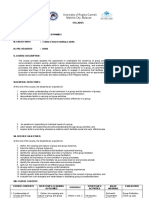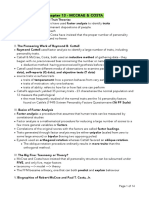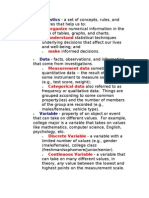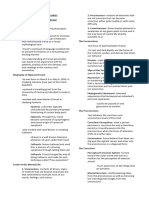100%(1)100% found this document useful (1 vote)
199 viewsUnderstanding Group Dynamics
Kurt Lewin was the first to coin the term "group dynamics" to describe the positive and negative forces within groups. Several theorists contributed to the understanding of group dynamics, including Wertheimer, Wundt, Durkheim, Le Bon, and McDougall. Lewin established the first research center devoted to studying group dynamics. There are various models of group development, including linear and cyclical models. Tuckman's model outlines the key stages of group development as forming, storming, norming, performing, and adjourning. Effective facilitation and preparation is important for guiding groups through each stage of development.
Uploaded by
Jeremiah MagcalasCopyright
© © All Rights Reserved
Available Formats
Download as PPT, PDF, TXT or read online on Scribd
100%(1)100% found this document useful (1 vote)
199 viewsUnderstanding Group Dynamics
Kurt Lewin was the first to coin the term "group dynamics" to describe the positive and negative forces within groups. Several theorists contributed to the understanding of group dynamics, including Wertheimer, Wundt, Durkheim, Le Bon, and McDougall. Lewin established the first research center devoted to studying group dynamics. There are various models of group development, including linear and cyclical models. Tuckman's model outlines the key stages of group development as forming, storming, norming, performing, and adjourning. Effective facilitation and preparation is important for guiding groups through each stage of development.
Uploaded by
Jeremiah MagcalasCopyright
© © All Rights Reserved
Available Formats
Download as PPT, PDF, TXT or read online on Scribd
You are on page 1/ 23
Understanding Group Dynamics
History of Group Dynamics
• "the whole is greater than the sum of its parts"
A social group is an entity that has qualities which
cannot be understood just by studying the
individuals that make up the group. In 1924,
Gestalt psychologist Max Wertheimer identified
this fact, stating "There are entities where the
behaviour of the whole cannot be derived from
its individual elements nor from the way these
elements fit together; rather the opposite is true:
the properties of any of the parts are determined
by the intrinsic structural laws of the whole".
History of Group Dynamics
• Wilhelm Wundt (1832–1920), credited as the
founder of experimental psychology, had a
particular interest in the psychology of
communities, which he believed possessed
phenomena (human language, customs, and
religion) that could not be described through a
study of the individual.
• Émile Durkheim (1858–1917), who was
influenced by Wundt, also recognized collective
phenomena, such as public knowledge.
History of Group Dynamics
Other key theorists:
• Gustave Le Bon (1841–1931) who believed that
crowds possessed a 'racial unconscious' with
primitive, aggressive, and antisocial instincts,
and William McDougall (psychologist), who
believed in a 'group mind,' which had a distinct
existence born from the interaction of
individuals.
History of Group Dynamics
Other key theorists:
• Gustave Le Bon (1841–1931) who believed that
crowds possessed a 'racial unconscious' with
primitive, aggressive, and antisocial instincts,
and William McDougall (psychologist), who
believed in a 'group mind,' which had a distinct
existence born from the interaction of
individuals.
History of Group Dynamics
Other key theorists:
• Ultimately, it was social psychologist Kurt Lewin
(1890–1947) who coined the term group
dynamics to describe the positive and negative
forces within groups of people. In 1945, he
established The Group Dynamics Research
Center at the Massachusetts Institute of
Technology, the first institute devoted explicitly to
the study of group dynamics. Throughout his
career, Lewin was focused on how the study of
group dynamics could be applied to real-world,
social issues.
History of Group Dynamics
Other key theorists:
• An increasing amount of research has applied
evolutionary psychology principles to group
dynamics. Humans are argued to have evolved
in an increasingly complicated social
environment and to have many adaptations
concerned with group dynamics. Examples
include mechanisms for dealing with status,
reciprocity, identifying cheaters, ostracism,
altruism, group decision, leadership, and
intergroup relations.
Group Dynamics
• Communication patterns - the flow of information
within the group and they are typically described as
either centralized or decentralized.
a. Centralized pattern communications tend to flow from
one source to all group members. Centralized
communications allow standardization of information, but
may restrict the free flow of information.
b. Decentralized communications make it easy to share
information directly between group members. When
decentralized, communications tend to flow more freely,
but the delivery of information may not be as fast or
accurate as with centralized communications. Another
potential downside of decentralized communications is
the sheer volume of information that can be generated,
particularly with electronic media.
Group Dynamics
• Group Cohesion - sum of all the factors
causing members of a group to stay in the group
or be attracted to the group. You can think of
group cohesion as the social glue that binds a
group together.
• The bonds that link group members to one
another and to their group as a whole are not
believed to develop spontaneously. Over the
years, social scientists have explained the
phenomenon of group cohesiveness in different
ways. Some have suggested that cohesiveness
among group members develops from a
heightened sense of belonging, teamwork,
interpersonal and group-level attraction.
Group Dynamics
Culture of a Group
1. the intellectual purpose - "reason" for being
together.
2. the emotional attractor - connects people's
hearts to the work
3. the artifacts they create, collective knowledge
they acquire, and practices they develop
together
4. the deeper spiritual connection or intention that
unifies the group
STAGES OF GROUP DEVELOPMENT
Theories of Group Development
1. Linear Model - groups develop progressively as
if in a straight line.
2. Cyclical Model - groups development follows a
cycle, going around and around through th e
various stages but usually reaching a higher
level development each time.
STAGES OF GROUP DEVELOPMENT
Bruce Tuckman
(Nov 24, 1938 - Mar 13, 2016)
He proposed the model of group
development. He said that these
phases are all necessary and
inevitable in order for the team to
grow, face up to challenges, tackle
problems, find solutions, plan
work, and deliver results.
STAGES OF GROUP DEVELOPMENT
1. Forming
The team meets and learns about the opportunities and
challenges, and then agrees on goals and begins to
tackle the tasks. Team members tend to behave quite
independently. They may be motivated but are usually
relatively uninformed of the issues and objectives of the
team. Team members are usually on their best behavior
but very focused on themselves. Mature team members
begin to model appropriate behavior even at this early
phase.
STAGES OF GROUP DEVELOPMENT
1. Forming
The meeting environment also plays an important role to
model the initial behaviors of each individual. The major
task functions also concern orientation. Members
attempt to become oriented to the tasks as well as to
one another. Discussion centers around defining the
scope of the task, how to approach it, and similar
concerns. To grow from this stage to the next, each
member must relinquish the comfort of non-threatening
topics and risk the possibility of conflict.
STAGES OF GROUP DEVELOPMENT
1. Forming
a. Acceptance Anxieties - "Will I be liked,
wanted or rejected or will I be disliked, unwanted
or rejected?"
b. Orientation Anxieties - "Will I understand or
make sense; and can I find my identity in the
group?"
c. Performance Anxieties - "Will I be
competent and be able to have control or
personal power here?
STAGES OF GROUP DEVELOPMENT
2. Storming
As a group members begin to feel more comfortable and
self-assured in the group, members start to seel
individual roles and spaces. At this stage, there is
uncertainty about what can be achieved. Facilitator must
know why he is doing what he is doing.
To help with storming, plenty of group activity can be
used in which everyone can get involved and that
members/people experience success in what they do.
*Easy, safe but interesting activities and exercises are
useful in creating sense of achievement.
STAGES OF GROUP DEVELOPMENT
3. Norming
Having explored and tested out roles and having
resolved issues of power and questions about the value
of the group, members begin to get a sense of what is
required and rules and norms become established.
These can be either positive or negative in terms of the
group's objectives and facilitators have a role in ensuring
the norms that develop are constructive.
STAGES OF GROUP DEVELOPMENT
4. Performing
Members are now readily cooperating and
contributing to the group tasks; the aims of the
group are being lived in the life and processes of
the group, and the influence of the group on
individuals are high.
The group is largely self-sufficient resource,
using all the skills and potential of the members
to solve its problems.
STAGES OF GROUP DEVELOPMENT
5. Mourning
Members may experience a sense of loss of
valued support, feedback and opportunity for
personal development when group ends. They
may react in a number of different ways:
a. the group may revert to earlier behaviors
b. there may be euphoria abort what has been achieved
c. there may be frustration about what has not been
achieved
To ensure that the group ends successfully,
the facilitator/s should make sure that the end is
properly acknowledged and should provide a
structure to enable this to happen
a. KEEPING THE END IN SIGHT - making sure
that group members are aware of the limited life of
the group right from the start and keep reminding
them at intervals
b. REVIEW - at the end, review what the group
has done and what it has experienced- and within
that review, what each individual has experiences
and contributed
c. EVALUATE - following on from the review,
evaluate what group and its members have
achieved, especially in relation to the original aims
of the group. Remember that this is an opportunity
to evaluate the performance of the workers and
the success of the programme.
d. ENDING RELATIONSHIP - you will need to
provide on opportunity for members to say
"goodbye" and deal with any "unfinished business"
between individuals, whether members of
facilitators.
e. PREPARATION FOR THE POST-GROUP
STAGE - as people leave the group, they may
need alternative sources of support/action/contact,
and the group can help each member plan
accordingly. What sources can the access? do
you need to have a reintroduction to the person's
indovidual social worker?
f. ENDING - some event or happening to mark the
ending of a group is often very helpful. This might
be some special group exercise, a social
occassion, such as a special meal or party, or
some creative activity devised by a group
members.
Reference:
• Groupwork Practice in Social Work 2nd
Edition, Trevor Lindsay and Sue Orton,
Chapter 5 pages 74-79
You might also like
- University of Regina Carmeli Malolos City, Bulacan: Syllabus I. Course Code: Psy 12No ratings yetUniversity of Regina Carmeli Malolos City, Bulacan: Syllabus I. Course Code: Psy 127 pages
- Chapter One: The History of I/O PsychologyNo ratings yetChapter One: The History of I/O Psychology17 pages
- Week 10 - Personality Assessment - An OverviewNo ratings yetWeek 10 - Personality Assessment - An Overview10 pages
- Models and Approaches To Health Promotion Basmah KattanNo ratings yetModels and Approaches To Health Promotion Basmah Kattan6 pages
- Contents:: An Introduction To Social Psychology by Miles Hewstone, Wolfgang Stroebe, KlausNo ratings yetContents:: An Introduction To Social Psychology by Miles Hewstone, Wolfgang Stroebe, Klaus36 pages
- 15 - The Assesment of People With Disabilities100% (1)15 - The Assesment of People With Disabilities16 pages
- Stage 6: Postgroup Issues-Evaluation and Follow-UpNo ratings yetStage 6: Postgroup Issues-Evaluation and Follow-Up4 pages
- Chapter 1 Introduction To Industrial PsychologyNo ratings yetChapter 1 Introduction To Industrial Psychology35 pages
- Unit 3 GROUP BEHAVIOUR AND CONFLICT GROUP BEHAVIOURNo ratings yetUnit 3 GROUP BEHAVIOUR AND CONFLICT GROUP BEHAVIOUR14 pages
- Barefoot Movie (Features of Abnormality)No ratings yetBarefoot Movie (Features of Abnormality)4 pages
- Socialization and Personality DevelopmentNo ratings yetSocialization and Personality Development19 pages
- Group Dynamics and Leadership: Practices in Spiritual Care & Counselling100% (1)Group Dynamics and Leadership: Practices in Spiritual Care & Counselling14 pages
- Cohen Based Summary of Psychological Testing AssessmentNo ratings yetCohen Based Summary of Psychological Testing Assessment31 pages
- PSYCHOLOGICAL ASSESSMENT CHAPTER 3-6 (Summary) 1No ratings yetPSYCHOLOGICAL ASSESSMENT CHAPTER 3-6 (Summary) 111 pages
- Interpersonal Attraction & Close RelationshipsNo ratings yetInterpersonal Attraction & Close Relationships7 pages
- Pag-Ibig (Love), Pagnanasa (Desire) :: Filipino Adolescents and Sexual RisksNo ratings yetPag-Ibig (Love), Pagnanasa (Desire) :: Filipino Adolescents and Sexual Risks14 pages
- Dynamics of Group Formation and Types of Groups: Neethu DilverNo ratings yetDynamics of Group Formation and Types of Groups: Neethu Dilver28 pages
- MPU 2063 Introduction To Psychology Course OutlineNo ratings yetMPU 2063 Introduction To Psychology Course Outline7 pages
- Handbook of Rehabilitation Psychology (Lisa A. Brenner, Stephanie A. Reid-Arndt Etc.)No ratings yetHandbook of Rehabilitation Psychology (Lisa A. Brenner, Stephanie A. Reid-Arndt Etc.)1,092 pages
- Ethical Issues in Psychological ResearchNo ratings yetEthical Issues in Psychological Research5 pages
- Developmental Psychology Reviewer 4 PDF FreeNo ratings yetDevelopmental Psychology Reviewer 4 PDF Free6 pages
- Angoluan - Literature Matrix Sec 3 SummerNo ratings yetAngoluan - Literature Matrix Sec 3 Summer4 pages
- Roma Flores Psychological Test Development ProceduresNo ratings yetRoma Flores Psychological Test Development Procedures13 pages
- Almonte Christian Vine R Nature of DynamicsNo ratings yetAlmonte Christian Vine R Nature of Dynamics38 pages
- Theories of Learning: By: Jeremiah G. Magcalas B.S. in Social WorkNo ratings yetTheories of Learning: By: Jeremiah G. Magcalas B.S. in Social Work37 pages
- The Concept of Community in Social Work Practice: Reported By: Patricia L. DelosreyesNo ratings yetThe Concept of Community in Social Work Practice: Reported By: Patricia L. Delosreyes17 pages
- Knowledge and Philosophical Foundations of The Social Work Profession0% (3)Knowledge and Philosophical Foundations of The Social Work Profession1 page
- Kasambahay Unified Registration Form PDFNo ratings yetKasambahay Unified Registration Form PDF2 pages
- 2012 Census of Philippine Business and Industry: ECONOMY-WIDE Final Results For NCRNo ratings yet2012 Census of Philippine Business and Industry: ECONOMY-WIDE Final Results For NCR2 pages
- Teaching Political Science in I.R. of Iran: Opportunities and ChallengesNo ratings yetTeaching Political Science in I.R. of Iran: Opportunities and Challenges11 pages
- Teaching Political Science in I.R. of Iran: Opportunities and ChallengesNo ratings yetTeaching Political Science in I.R. of Iran: Opportunities and Challenges11 pages
- Communication Skills and Personality DevelopmentNo ratings yetCommunication Skills and Personality Development3 pages
- WEEK 8 Supervising Office Employess Part 1No ratings yetWEEK 8 Supervising Office Employess Part 116 pages
- UN Convention On The Rights of The ChildNo ratings yetUN Convention On The Rights of The Child16 pages
- Elements of Total Quality Management (2)No ratings yetElements of Total Quality Management (2)5 pages
- Ped9c Report - School Culture - Principles and TheoriesNo ratings yetPed9c Report - School Culture - Principles and Theories16 pages
- Impacts of Parental Involvement Chap 1 3 Final EditNo ratings yetImpacts of Parental Involvement Chap 1 3 Final Edit14 pages
- The Uganda National Parenting GuidelineNo ratings yetThe Uganda National Parenting Guideline39 pages
- Bias-Based Cyberaggression in Northwestern Mexican Adolescentes. Associations With Moral Disengagement - Navarro-Rodríguez, Vera y BaumanNo ratings yetBias-Based Cyberaggression in Northwestern Mexican Adolescentes. Associations With Moral Disengagement - Navarro-Rodríguez, Vera y Bauman26 pages
- The Influence of Social Media On Adolescent Mental HealthNo ratings yetThe Influence of Social Media On Adolescent Mental Health2 pages
- Quiz:: Match The Description/ Concepts in Column A With The Philosophers/ Theorists in Column BNo ratings yetQuiz:: Match The Description/ Concepts in Column A With The Philosophers/ Theorists in Column B18 pages
- University of Regina Carmeli Malolos City, Bulacan: Syllabus I. Course Code: Psy 12University of Regina Carmeli Malolos City, Bulacan: Syllabus I. Course Code: Psy 12
- Models and Approaches To Health Promotion Basmah KattanModels and Approaches To Health Promotion Basmah Kattan
- Contents:: An Introduction To Social Psychology by Miles Hewstone, Wolfgang Stroebe, KlausContents:: An Introduction To Social Psychology by Miles Hewstone, Wolfgang Stroebe, Klaus
- Stage 6: Postgroup Issues-Evaluation and Follow-UpStage 6: Postgroup Issues-Evaluation and Follow-Up
- Unit 3 GROUP BEHAVIOUR AND CONFLICT GROUP BEHAVIOURUnit 3 GROUP BEHAVIOUR AND CONFLICT GROUP BEHAVIOUR
- Group Dynamics and Leadership: Practices in Spiritual Care & CounsellingGroup Dynamics and Leadership: Practices in Spiritual Care & Counselling
- Cohen Based Summary of Psychological Testing AssessmentCohen Based Summary of Psychological Testing Assessment
- Pag-Ibig (Love), Pagnanasa (Desire) :: Filipino Adolescents and Sexual RisksPag-Ibig (Love), Pagnanasa (Desire) :: Filipino Adolescents and Sexual Risks
- Dynamics of Group Formation and Types of Groups: Neethu DilverDynamics of Group Formation and Types of Groups: Neethu Dilver
- MPU 2063 Introduction To Psychology Course OutlineMPU 2063 Introduction To Psychology Course Outline
- Handbook of Rehabilitation Psychology (Lisa A. Brenner, Stephanie A. Reid-Arndt Etc.)Handbook of Rehabilitation Psychology (Lisa A. Brenner, Stephanie A. Reid-Arndt Etc.)
- Roma Flores Psychological Test Development ProceduresRoma Flores Psychological Test Development Procedures
- Theories of Learning: By: Jeremiah G. Magcalas B.S. in Social WorkTheories of Learning: By: Jeremiah G. Magcalas B.S. in Social Work
- The Concept of Community in Social Work Practice: Reported By: Patricia L. DelosreyesThe Concept of Community in Social Work Practice: Reported By: Patricia L. Delosreyes
- Knowledge and Philosophical Foundations of The Social Work ProfessionKnowledge and Philosophical Foundations of The Social Work Profession
- 2012 Census of Philippine Business and Industry: ECONOMY-WIDE Final Results For NCR2012 Census of Philippine Business and Industry: ECONOMY-WIDE Final Results For NCR
- Teaching Political Science in I.R. of Iran: Opportunities and ChallengesTeaching Political Science in I.R. of Iran: Opportunities and Challenges
- Teaching Political Science in I.R. of Iran: Opportunities and ChallengesTeaching Political Science in I.R. of Iran: Opportunities and Challenges
- Ped9c Report - School Culture - Principles and TheoriesPed9c Report - School Culture - Principles and Theories
- Impacts of Parental Involvement Chap 1 3 Final EditImpacts of Parental Involvement Chap 1 3 Final Edit
- Bias-Based Cyberaggression in Northwestern Mexican Adolescentes. Associations With Moral Disengagement - Navarro-Rodríguez, Vera y BaumanBias-Based Cyberaggression in Northwestern Mexican Adolescentes. Associations With Moral Disengagement - Navarro-Rodríguez, Vera y Bauman
- The Influence of Social Media On Adolescent Mental HealthThe Influence of Social Media On Adolescent Mental Health
- Quiz:: Match The Description/ Concepts in Column A With The Philosophers/ Theorists in Column BQuiz:: Match The Description/ Concepts in Column A With The Philosophers/ Theorists in Column B








































































































